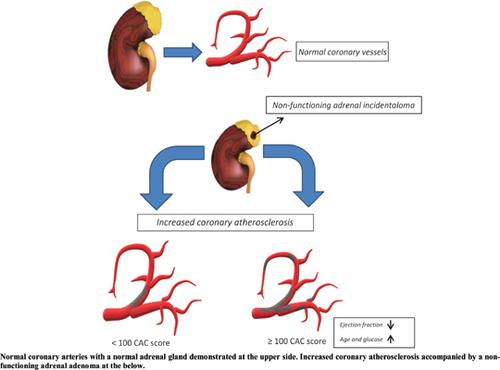Endocrine, Metabolic & Immune Disorders - Drug Targets ( IF 1.9 ) Pub Date : 2021-06-30 , DOI: 10.2174/1871530320666200910110337 Oguz Akkus 1 , Gamze Akkus 2 , Onur Kaypakli 1 , Fatma Keles Ozturk 3 , Eren Gurkan 4 , Ozkan Bekler 1 , Fatih Sen 1 , Fatih Yalcin 1

|
Aim: We evaluated cardiovascular (CV) risk stratification for nonfunctioning adrenal incidentalomas (NFAIs) via the coronary-artery-calcium (CAC) score.
Materials and Methods: The participants were patients with NFAI (n = 55). They were compared to patients with chest pain, a low-intermediate Framingham-risk score, and a non-diagnostic treadmill- exercise test, which served as the control group (n = 49). Subsequently, the NFAI group was subdivided according to a CAC score of <100 Agatston units – mild coronary-artery calcification (n = 40) – and ≥100 Agatston units – moderate-to-severe calcification (n = 15).
Results: Similar rates of traditional risk factors were observed between the NFAI and control groups, and lower low-density lipoprotein cholesterol rates were observed in the NFAI group. The CAC score was significantly higher for the NFAI group than the control group. Glucose, potassium, adrenocorticotropic-hormone, and basal-cortisol levels were higher in those with a CAC score of ≥100. High-density-lipoprotein cholesterol estimated glomerular filtration rate and ejection fraction (EF) were higher in those with a CAC score of <100. Adenoma size and location were similar between the groups. Age, EF, and glucose were the most significant variables related to CAC score in patients with NFAI, at ≥100 Agatston units.
Discussion: Patients with a low-intermediate CV risk profile and NFAI have a higher risk of atherosclerosis when compared to patients with a low-intermediate CV risk profile, but no NFAI.
Conclusion: In patients with NFAI, CAC score evaluation may be used to predict increased atherosclerosis, especially in patients of an older age with higher glucose and decreased EF.
中文翻译:

非功能性肾上腺偶发瘤患者冠状动脉钙化评分的增加
目的:我们通过冠状动脉钙 (CAC) 评分评估了无功能肾上腺偶发瘤 (NFAI) 的心血管 (CV) 风险分层。
材料和方法:参与者是 NFAI 患者(n = 55)。将他们与胸痛、中低弗雷明汉风险评分和非诊断性跑步机运动测试的患者进行比较,后者作为对照组(n = 49)。随后,根据 CAC 评分<100 Agatston 单位——轻度冠状动脉钙化(n = 40)——和≥100 Agatston 单位——中度至重度钙化(n = 15)对 NFAI 组进行细分。
结果:在 NFAI 组和对照组之间观察到的传统危险因素发生率相似,在 NFAI 组中观察到较低的低密度脂蛋白胆固醇率。NFAI 组的 CAC 评分显着高于对照组。CAC 评分≥100 的患者的葡萄糖、钾、促肾上腺皮质激素和基础皮质醇水平较高。CAC 评分 <100 的患者的高密度脂蛋白胆固醇估计肾小球滤过率和射血分数 (EF) 较高。各组之间的腺瘤大小和位置相似。年龄、EF 和血糖是与 NFAI 患者 CAC 评分相关的最重要变量,≥100 Agatston 单位。
讨论:与具有中低 CV 风险但没有 NFAI 的患者相比,具有中低 CV 风险和 NFAI 的患者发生动脉粥样硬化的风险更高。
结论:在NFAI患者中,CAC评分评估可用于预测动脉粥样硬化的增加,尤其是对于高血糖和EF降低的高龄患者。



























 京公网安备 11010802027423号
京公网安备 11010802027423号